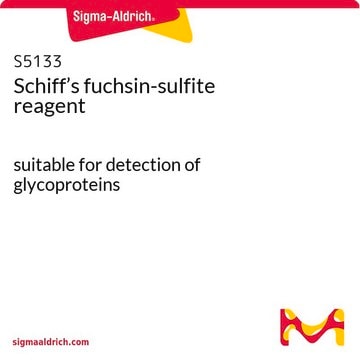Products may be shipped at a different temperature than the recommended long-term storage temperature. If the product quality is sensitive to short-term exposure to conditions other than the recommended long-term storage, it will be shipped on wet or dry-ice. If the product quality is NOT affected by short-term exposure to conditions other than the recommended long-term storage, it will be shipped at ambient temperature. As shipping routes are configured for minimum transit times, shipping at ambient temperature helps control shipping costs for our customers. For more information, please refer to the Storage and Transport Conditions document: https://www.sigmaaldrich.com/deepweb/assets/sigmaaldrich/marketing/global/documents/316/622/storage-transport-conditions-mk.pdf
114189
Acetyl chloride
reagent grade, 98%
Sinonimo/i:
Acetic acid chloride, Acetic chloride, Ethanoyl chloride
Scegli un formato
Scegli un formato
About This Item
Prodotti consigliati
Grado
reagent grade
Livello qualitativo
Densità del vapore
2.7 (vs air)
Tensione di vapore
11.69 psi ( 20 °C)
32.33 psi ( 55 °C)
Saggio
98%
Stato
liquid
Temp. autoaccensione
1353 °F
Limite di esplosione
19 %
Indice di rifrazione
n20/D 1.389 (lit.)
P. ebollizione
52 °C (lit.)
Punto di fusione
−112 °C (lit.)
Densità
1.104 g/mL at 25 °C (lit.)
Gruppo funzionale
acyl chloride
Stringa SMILE
CC(Cl)=O
InChI
1S/C2H3ClO/c1-2(3)4/h1H3
WETWJCDKMRHUPV-UHFFFAOYSA-N
Cerchi prodotti simili? Visita Guida al confronto tra prodotti
Categorie correlate
Descrizione generale
Acetyl chloride is a colorless acyl halide. On reaction with ammonia and alcohols, it affords acetamide and esters of acetic acid, respectively.[2] Structural parameters and rotational constants of its isotopic forms have been evaluated from the microwave spectral investigations.[3]
Avvertenze
Danger
Indicazioni di pericolo
Consigli di prudenza
Classi di pericolo
Eye Dam. 1 - Flam. Liq. 2 - Skin Corr. 1B
Rischi supp
Codice della classe di stoccaggio
3 - Flammable liquids
Classe di pericolosità dell'acqua (WGK)
WGK 1
Punto d’infiammabilità (°F)
41.0 °F - closed cup
Punto d’infiammabilità (°C)
5 °C - closed cup
Scegli una delle versioni più recenti:
Possiedi già questo prodotto?
I documenti relativi ai prodotti acquistati recentemente sono disponibili nell’Archivio dei documenti.
I clienti hanno visto anche
-
How is shipping temperature determined? And how is it related to the product storage temperature?
1 answer-
Helpful?
-
-
How can I determine the shelf life / expiration / retest date of this product?
1 answer-
If this product has an expiration or retest date, it will be shown on the Certificate of Analysis (COA, CofA). If there is no retest or expiration date listed on the product's COA, we do not have suitable stability data to determine a shelf life. For these products, the only date on the COA will be the release date; a retest, expiration, or use-by-date will not be displayed.
For all products, we recommend handling per defined conditions as printed in our product literature and website product descriptions. We recommend that products should be routinely inspected by customers to ensure they perform as expected.
For products without retest or expiration dates, our standard warranty of 1 year from the date of shipment is applicable.
For more information, please refer to the Product Dating Information document: https://www.sigmaaldrich.com/deepweb/assets/sigmaaldrich/marketing/global/documents/449/386/product-dating-information-mk.pdfHelpful?
-
Active Filters
Il team dei nostri ricercatori vanta grande esperienza in tutte le aree della ricerca quali Life Science, scienza dei materiali, sintesi chimica, cromatografia, discipline analitiche, ecc..
Contatta l'Assistenza Tecnica.














